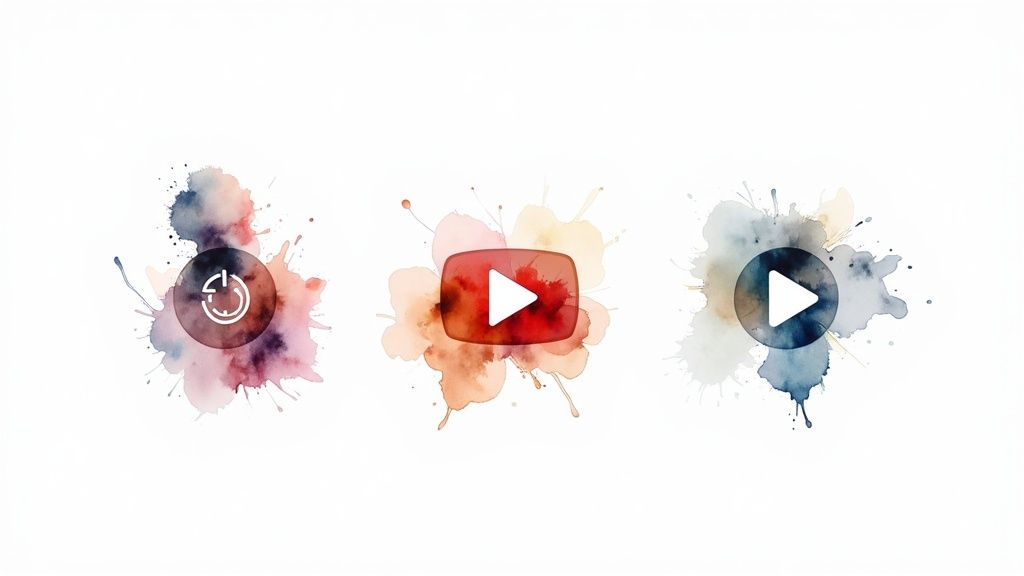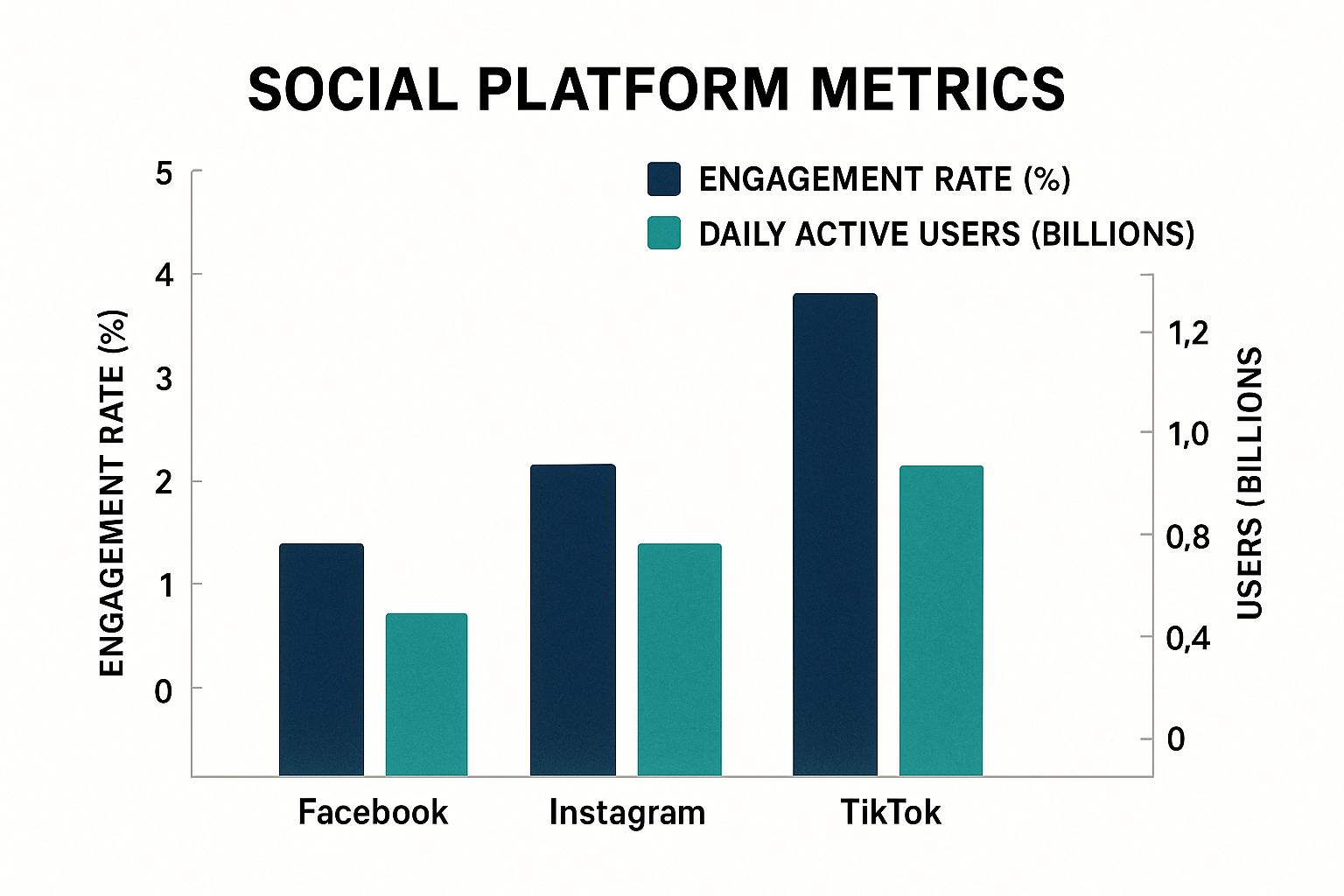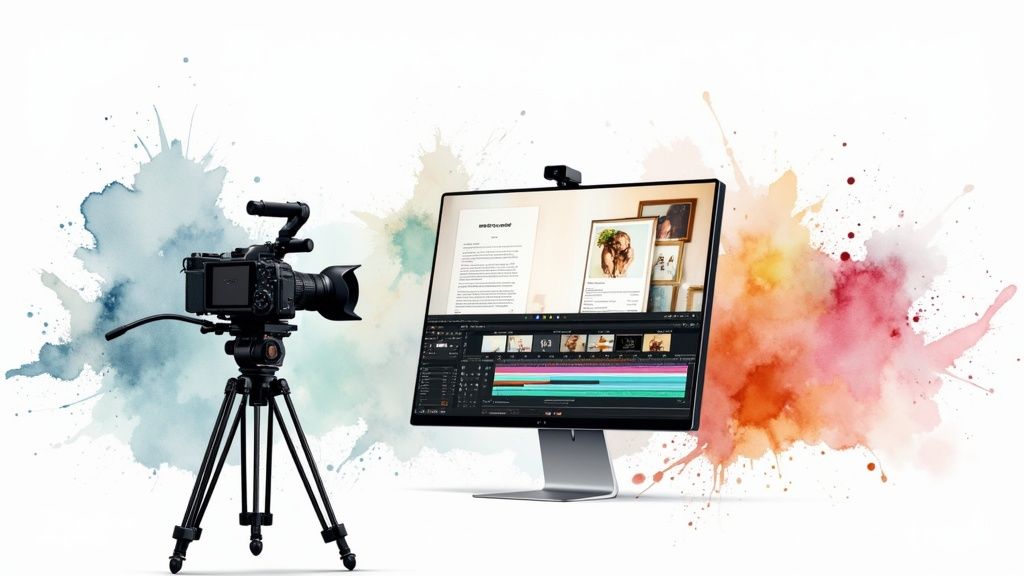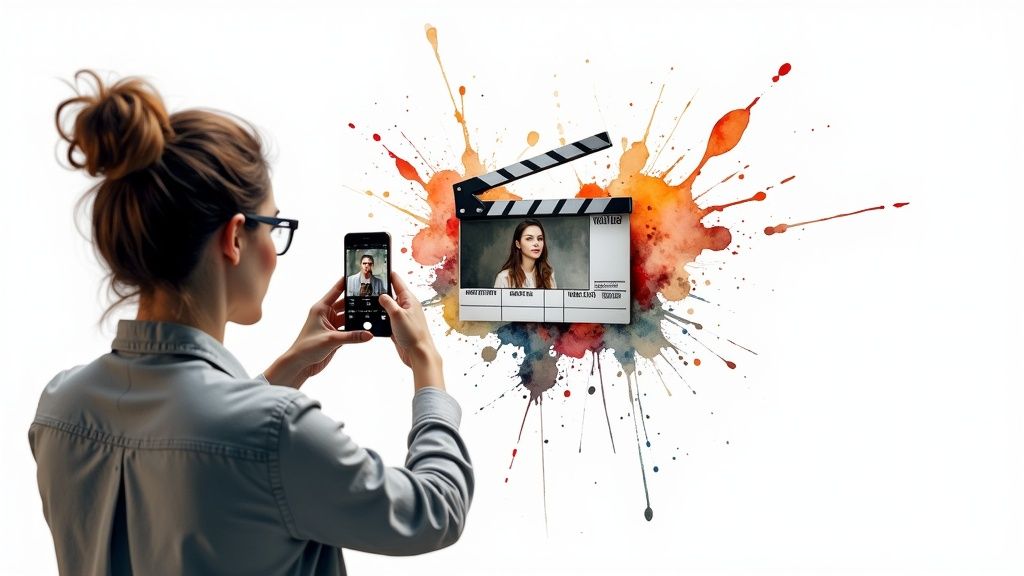Unlock growth with our guide to video social media marketing. Learn proven strategies to create video content that engages audiences and drives real results.
In This Article
Subscribe to our newsletter
Let’s start with the basics. Video social media marketing is simply the art of using video on platforms like Instagram, TikTok, and Facebook to build your brand, grow a community, and hit your business targets. It's about swapping out static posts for dynamic, engaging visuals that tell a story and truly connect with people.
Why Video Dominates Social Media Today

Think about your own social media habits. When you scroll through your feed, what do you see most? Videos, right? That’s no accident. Video has become the native language of social media because it perfectly matches how we consume content today: fast, easy to digest, and visually engaging.
This isn't just a trend; it's rooted in how our brains work. We're wired to process visuals 60,000 times faster than plain text. This makes video an incredibly powerful way to communicate. In just a few seconds, a video can spark an emotion, show how a product works, or tell a compelling story in a way a wall of text never could.
In the world of social media, where you have milliseconds to grab someone's attention, that efficiency is everything. A good video can literally stop the scroll, pulling a user in with movement and sound. It’s an immersive experience that creates a much deeper, more personal connection than other formats.
Building Trust and Explaining Complex Ideas
When was the last time you needed to learn something new or check out a product? Did you grab a manual or just pull up a quick tutorial video? Most of us go for the video. Why? Because video is fantastic at building trust and making complicated things feel simple. Seeing a real person's face or a product in action makes a brand feel more human and transparent.
A smart video social media marketing plan is your most powerful tool for cutting through the digital noise. It allows you to forge genuine connections with your audience by showing, not just telling, them who you are and what you offer.
This is exactly why video works so well for everything from product demos to behind-the-scenes glimpses of your company culture. It tears down the barriers between you and your audience, making your brand more approachable and relatable. And that’s how you build a loyal community that sticks around.
Before you map out your video strategy, it’s crucial to understand that not all platforms are the same. A killer TikTok video might fall flat on LinkedIn. You need to tailor your content to fit the audience's expectations on each channel.
Here’s a quick guide to help you think strategically about your video formats.
Tailoring Your Video for Each Social Platform
A breakdown of video formats and strategies for top social media platforms, helping you align content with audience expectations.
| Platform | Primary Video Format | Optimal Length | Key Strategic Focus |
|---|---|---|---|
| TikTok | Vertical (9:16) | 15-60 seconds | Trends, entertainment, raw and authentic content |
| Vertical (9:16) for Reels & Stories; Square (1:1) for Feed | 30-90 seconds | High-quality visuals, storytelling, behind-the-scenes | |
| Vertical (4:5) or Square (1:1) | 1-3 minutes | Community building, educational content, live streams | |
| YouTube | Horizontal (16:9) for long-form; Vertical for Shorts | 2-10+ minutes | In-depth tutorials, expert interviews, SEO-driven content |
| Horizontal (16:9) or Square (1:1) | 1-2 minutes | Professional insights, company culture, industry news |
Remember, these are just starting points. The best way to know what works is to test, analyze your data, and see what your specific audience responds to.
The Undeniable Data Behind Video's Rise
The numbers don't lie. They just confirm what our own scrolling habits have been telling us for years. Video's influence is massive, with some projections showing it will make up 82% of all internet traffic by 2025. This explosion has been fueled by our shift to mobile-first platforms.
What's more, the boom in vertical video has completely changed the game. On platforms like Instagram and Facebook, vertical ads are reportedly watched to completion 90% of the time. Compare that to just 14% for horizontal videos. This tells a powerful story for any marketer trying to get their video social media marketing right. You can dive deeper into these trends by checking out more video marketing statistics and their impact.
The data paints a clear picture: if you're not creating video, you're effectively invisible to a huge chunk of your audience. A solid video strategy isn't just a "nice-to-have" anymore. It's an absolute must for staying relevant and growing your brand.
Building a Goal-Driven Video Content Plan
Jumping into video creation without a clear plan is like starting a road trip without a map. You might stumble upon some interesting things, but you’ll probably just end up lost and out of gas. A winning video social media marketing strategy always starts by defining what success actually looks like for your brand.
Are you trying to get your name in front of more people? Capture high-quality leads? Or drive sales directly?
Getting crystal clear on your primary objective is the foundation for everything that follows. It dictates the kind of videos you make, the platforms you focus on, and the metrics you obsess over. Without this focus, you're just making noise—entertaining, maybe, but not moving the needle on your actual business goals.
Define Your Primary Video Marketing Goal
Before you even think about storyboards or scripts, you need to anchor your efforts to a specific business outcome. Your goals will almost always fall into one of three big buckets, and each one demands a totally different creative approach.
- Awareness: The main goal here is simple: introduce your brand to people who’ve never heard of you. These videos need to be engaging, highly shareable, and show off your brand’s personality—not push a hard sell. Think entertaining Reels, compelling brand stories, or fun behind-the-scenes glimpses.
- Consideration: At this stage, your audience knows who you are. Now you need to build trust and show them why you're the right choice. Your videos should educate, inform, and solve a problem. Great examples include product demos, how-to tutorials, customer testimonials, and case studies.
- Conversion: This is where you ask for the sale or another specific action. These videos need a strong, unmissable call-to-action (CTA). We're talking about promos for a limited-time offer, detailed service walkthroughs, or direct-response ads designed to get viewers to a landing page.
Choosing one primary goal for a campaign doesn't mean you can't get secondary benefits. A fantastic educational video (Consideration) can easily get shared around, boosting Awareness. But having that single North Star keeps your creative sharp and your messaging on point.
Understand Your Audience and Competitors
Once you know what you want to achieve, you have to figure out who you're talking to. A deep dive into your target audience's habits isn't just a good idea; it's non-negotiable. What kind of videos are they already watching? Which platforms do they live on? What problems are they trying to solve that you can address?
At the same time, it’s always smart to see what your competitors are up to. This isn't about copying them. It's about finding opportunities they've missed.
A competitive analysis helps you find gaps in the market. If everyone else is creating polished, corporate-style videos, perhaps your angle is to be more raw, authentic, and behind-the-scenes. This is how you find your unique voice.
Pay attention to which of their videos get the most engagement and, just as importantly, which ones fall flat. Using an AI-powered platform like Aeon lets you analyze competitor content at scale, spotting patterns in topics, formats, and audience reactions that would be impossible to catch on your own. This kind of data-driven insight helps you strategically place your content where it will make the biggest splash.
Set Your Brand Voice and Track Success
Your brand’s personality needs to come through in every single video. Are you quirky and funny? Authoritative and educational? Your brand voice will dictate everything from your scripts and editing style to your music choices and on-screen talent. Consistency is everything—it’s how you become recognizable and memorable.
With your goals, audience, and voice locked in, the final piece is establishing your Key Performance Indicators (KPIs). These are the specific, hard numbers you’ll use to measure success.
| Goal | Key Performance Indicators (KPIs) to Track |
|---|---|
| Awareness | View Count, Reach, Impressions, Brand Mentions |
| Consideration | Watch Time, Audience Retention, Click-Through Rate (CTR), Comments, Shares |
| Conversion | Conversion Rate, Leads Generated, Sales, Sign-ups |
The world of video marketing is exploding. By 2025, an estimated 89% of companies are expected to use video in their marketing. Yet, many are still hesitant. A recent report found that 37% of businesses not using video say they simply lack the knowledge to start.
This highlights just how critical a clear, goal-driven plan is. You can learn more about the current state of video marketing for businesses and see how a structured approach can give you a serious edge. By building this framework first, you stop treating video like a creative whim and start treating it like a strategic asset that delivers real, measurable results.
Producing Social Media Videos That People Actually Watch

Let’s get one thing straight right away. You do not need a Hollywood-level budget or a massive film crew to create social media videos that connect with your audience. In fact, some of the most successful video social media marketing I’ve seen leans into authenticity and real value, not slick, over-the-top productions.
The whole process, from that first spark of an idea to the final polished edit, is more manageable than you think. What really matters to viewers is a clear message, decent audio, and content that feels genuine. Get that right, and you're already ahead of the game.
Pre-Production: Your Foundation for Success
Before you even think about hitting "record," a little bit of planning will save you a world of headaches later. This is the pre-production phase, where you transform a fuzzy idea into a solid plan.
Start by brainstorming concepts that tie back to your main goals. Are you trying to educate your audience, make them laugh, or inspire them to take action? Once you land on a core idea, sketch out a simple storyboard or shot list. This doesn't need to be a work of art—stick figures and quick notes on a doc are perfectly fine. The point is to visualize the video's flow, ensuring you capture every shot you need and that your story hangs together. Trust me, this simple step makes filming and editing so much smoother.
Choosing Your Gear and Setting Up Your Shot
The gear conversation is where a lot of people get hung up, but it really shouldn't be intimidating. The best camera you have is probably the one in your pocket. Modern smartphones can shoot in stunning 4K and are more than capable of producing professional-looking video for social media.
If you are going to invest a small amount of money, put it into these two areas: audio and lighting.
- Audio Quality is Non-Negotiable: People will forgive a slightly shaky camera, but they will bounce immediately if they can't hear you clearly. A cheap lavalier (lapel) mic that clips to your shirt can make a night-and-day difference in sound quality for a very small investment.
- Good Lighting Makes All the Difference: You don't need a fancy three-point lighting kit. The easiest and best solution is often free: natural light. Just face a window to get soft, even light on your face. If that's not an option, a simple ring light is an affordable alternative that provides consistent, flattering light.
Nailing these two things—clear audio and good lighting—will boost your video quality more than any expensive camera ever could.
Your goal is to create videos that feel authentic and engaging, not like sterile corporate ads. Focus on clear communication and genuine connection, and the production value will follow.
For example, imagine a skincare brand filming a simple "how-to" for a new serum. The setup could be as simple as a smartphone on a tripod, a lav mic clipped to the creator's shirt, and them sitting near a window for that nice, natural light. This setup feels personal and trustworthy, which is exactly the vibe you want on social media.
The Magic of Post-Production
With your footage in the can, it’s time to weave it all together into a compelling story. This editing phase, known as post-production, is where your video really comes alive. There's a whole world of user-friendly editing software out there, from free mobile apps like CapCut to more powerful desktop programs.
Editing is where you'll trim your clips, arrange them in the right order, and add those final touches that make a video "social-media-ready." One of the most critical elements here is pacing. In a world of endless scrolling, you need to keep your edits snappy and your clips short to hold onto that precious viewer attention.
Here’s a breakdown of the post-production elements that truly matter for your video social media marketing.
| Element | Why It's Critical | Pro Tip for Implementation |
|---|---|---|
| Captions/Subtitles | A staggering 85% of Facebook videos are watched with the sound off. Captions are your insurance policy, making sure your message lands even in silence. | Burn captions directly into the video file so they show up everywhere. Most modern editing apps can auto-generate these for you. |
| Branding | A subtle logo or a consistent brand color helps with brand recall and makes your content instantly recognizable in a crowded feed. | Tuck your logo in a corner where it’s visible but not distracting. The key is to be tasteful, not obnoxious. |
| Music & Sound Effects | The right background music can completely change the mood and emotional impact of your video. Sound effects can add a bit of punch and emphasis. | Stick to royalty-free music libraries to avoid copyright headaches. Make sure the music's vibe and tempo match your video's content. |
| Call-to-Action (CTA) | Every video needs a purpose. Tell your viewers what to do next—visit your site, follow your page, or drop a comment. | Be clear and direct with your CTA. You can put it on-screen as text, say it in the voiceover, and repeat it in the post description. |
Ultimately, creating videos that people actually watch comes down to respecting their time and attention. When you focus on a clear message, get the audio-visual fundamentals right, and edit thoughtfully, you can create compelling content that hits your marketing goals without needing a blockbuster budget.
Getting Your Videos Seen by the Right Audience
Look, creating a brilliant video is only half the battle. If it never reaches the right people, it’s just a beautifully crafted file taking up space on your hard drive. This is where smart distribution and optimization come in—turning your creation into a powerful asset that actually gets seen.
The process kicks off the second you finish editing. Your job now is to give social media algorithms every signal possible that your video is valuable and relevant to a specific audience. This is way more than just hitting "publish." It's a thoughtful approach to every little piece surrounding your video.
Crafting Magnetic Headlines and Thumbnails
Your video's thumbnail and headline are its digital storefront. On a crowded feed, they have a split second to convince someone to stop scrolling and click play. Think of them as a movie poster and tagline—they need to be compelling and promise something valuable.
A great thumbnail has a few key ingredients:
- It’s Clear and High-Quality: No blurry or dark images. Your visual needs to be crisp and easy to understand, even when it’s tiny.
- It’s Emotionally Resonant: Use faces showing strong emotions like excitement, curiosity, or even surprise. That human connection is a powerful magnet for clicks.
- It’s Text-Optimized: A few words of bold, easy-to-read text can add that crucial bit of context or spark curiosity. A thumbnail for a baking video saying "My BIGGEST Mistake!" is far more interesting than just a picture of a cake.
For headlines, you want to trigger curiosity or promise a solution. A headline like "New Product Update" is a snooze-fest. Instead, try something like, "The One Feature You've Been Waiting For Is Finally Here." See the difference? The second one creates intrigue and makes you need to know more.
The data below shows how different video strategies might play out across the major platforms.

It’s clear that while Facebook has a massive user base, platforms like TikTok and Instagram often deliver much higher organic engagement, making them perfect for grabbing attention and building awareness.
Optimizing Descriptions and Hashtags
Okay, so you’ve earned the click. Now what? Your video’s description and hashtags are what help the platform’s algorithm understand your content and who to show it to. Please, don't treat the description as an afterthought.
Use the first couple of lines to nail down the video's core value. From there, you can expand with relevant keywords, ask a question to get the comments rolling, and always include a clear call-to-action (CTA). This could be anything from asking viewers to follow your page to visiting a link.
Hashtags are your video's signposts. Here’s a simple strategy I stick to:
- Broad Hashtags: Use 1-2 popular tags (like #VideoMarketing) to cast a wide net.
- Niche Hashtags: Add 3-5 super-specific tags (like #EcommerceVideoTips) to connect with a more targeted, engaged group.
- Branded Hashtags: Always include one unique tag for your brand or campaign (e.g., #AeonInAction) to track conversations and see what people are creating.
A well-optimized video isn't just about what's in the video—it's about the entire package. The title, thumbnail, description, and tags work together to tell algorithms exactly who will love your content, dramatically increasing its organic reach.
Leveraging Paid Promotion and Repurposing
Organic reach is great, but sometimes your best content needs a little nudge. Paid promotion, when you use it strategically, can guarantee your video gets in front of a highly specific audience. You don't have to launch some massive campaign; even a small budget to "boost" a post that's already performing well can expand its reach significantly.
For more direct goals, like driving sales for an e-commerce store, running dedicated ad campaigns on platforms like Facebook or Instagram is a must. If that's your game, our guide on video marketing for e-commerce is packed with proven strategies to maximize your ROI.
And to truly work smarter, not harder, you have to embrace repurposing.
How to Repurpose Your Video Content
Repurposing is one of the most efficient things you can do in content marketing. You’re taking one big piece of content you worked hard on and spinning it into multiple assets for different channels. This table shows you just how one webinar can fuel your content calendar.
| Pillar Content (e.g., Webinar) | Repurposed Asset | Target Platform | Strategic Goal |
|---|---|---|---|
| Full 20-min Webinar | 60-second highlight reel with key takeaways | Instagram Reels, TikTok | Awareness & Engagement |
| Full 20-min Webinar | 3-minute video explaining one key concept | Facebook Feed, LinkedIn | Consideration & Education |
| Full 20-min Webinar | Quote graphic with a powerful statement | Instagram Feed, X (Twitter) | Engagement & Shareability |
| Full 20-min Webinar | Full webinar recording for evergreen value | YouTube | Lead Generation & SEO |
This approach squeezes every last drop of value from your initial production effort. Your core message hits different audiences across multiple touchpoints, all from one piece of work. As you get deeper into video, it’s a huge help to learn how to use YouTube to market your website effectively, as it’s often the home for your pillar content.
Measuring What Matters in Your Video Strategy

So, how do you actually know if your video efforts are paying off? In the world of social media video, it’s dangerously easy to get distracted by vanity metrics. A video hitting 100,000 views feels like a massive win, but if it didn't generate a single lead or sale, was it truly successful?
To get the real story, you have to look past the surface-level numbers. The truth is found in the data that connects your video’s performance directly to your business goals. This means zeroing in on the analytics that show how people are truly interacting with your content and—more importantly—what they do next.
The good news is you don’t need some ridiculously complex analytics suite to get started. Every major social platform—from Instagram and TikTok to YouTube and Facebook—has powerful, built-in analytics tools. The real trick is knowing what to look for and how to translate those numbers into action.
Moving Beyond Simple View Counts
Let’s be honest: a "view" is a notoriously unreliable metric. On some platforms, it’s counted after just three seconds, often with the sound completely off. A far more meaningful indicator of genuine interest is Watch Time. This metric shows you the total amount of time people have spent watching your video. A high watch time is a powerful signal to the algorithms that your content is valuable, which can give your organic reach a serious boost.
Another absolutely critical metric is Audience Retention. This gives you a moment-by-moment graph of when viewers are dropping off. See a steep decline in the first five seconds? Your hook isn't landing. Notice a massive drop-off right before your call-to-action? You probably waited too long to get to the point. Analyzing this graph is like getting a free roadmap to improve your editing and storytelling.
Forget about chasing views. Focus on audience retention. A video that holds 60% of its audience to the end is far more valuable than a viral clip that everyone abandons after a few seconds. That sustained attention is where real connection happens.
By digging into these deeper metrics, you stop asking "How many people saw this?" and start asking, "How many people cared enough to keep watching?" It's a fundamental shift in perspective that always leads to better content.
Connecting Video Performance to Business Goals
While engagement metrics tell you if your content is interesting, conversion metrics tell you if it's effective. This is where your video marketing starts to show a clear, undeniable return on investment.
The key is tracking actions that directly impact your bottom line.
- Click-Through Rate (CTR): This measures the percentage of viewers who clicked a link in your video's description, your bio, or an on-screen element. A healthy CTR proves your video successfully motivated viewers to take the next step.
- Conversion Rate: This is the ultimate metric. It tracks how many of those clicks resulted in a completed action, like a purchase, a newsletter sign-up, or a filled-out contact form.
- Cost Per Acquisition (CPA): If you're running paid video ads, this number is your north star. It tells you exactly how much you’re spending to land one new customer, making it essential for judging the financial efficiency of your campaigns.
Imagine a real estate agent tracking how many people clicked the link to a property listing after watching a video tour (CTR) and then how many of those clicks led to a scheduled showing (Conversion Rate). This creates a direct line from a video view to a tangible business outcome, proving the value of the strategy. For a more detailed look at how to structure your content for these outcomes, you can explore our complete guide on building a video content strategy to boost engagement and conversions.
Turning Data into Actionable Insights
Collecting data is pointless if you don't use it to make better decisions. The real magic happens when you analyze the numbers, form a hypothesis about what’s happening, and then test it. This continuous feedback loop is exactly how you systematically improve your results over time.
Don't just stare at the numbers; ask "why?"
- Low Watch Time: Why are people leaving so early? Is the intro too slow and boring? Was the topic not what the thumbnail promised?
- High Engagement, Low CTR: People are commenting and liking, but not clicking. Why? Is the call-to-action weak or unclear? Is the link buried or hard to find?
- Strong CTR, Low Conversions: They’re clicking but not converting. What’s going wrong on the other side? Does the landing page not match the video's promise? Is the checkout process a nightmare?
Based on your answers, start A/B testing. Create two versions of a video with different hooks. Pit a soft CTA against a more direct one. Experiment with completely different thumbnail styles. An AI-powered platform like Aeon can help you quickly generate variations of a single video, allowing you to test these different elements at scale. This saves you an immense amount of time while gathering the critical performance data you need.
This cycle of analysis, testing, and refinement transforms your video marketing from a guessing game into a data-driven science. It’s how you stop creating content you think your audience wants and start making content you know they’ll respond to.
Common Questions About Video Marketing
Even with a solid plan, jumping into video social media marketing can feel like you're navigating a new world. It's totally normal to have questions pop up as you get started. Let's tackle some of the most common ones I hear, so you can move forward with confidence.
https://www.youtube.com/embed/ZRCAfFKtbg0
How Long Should My Social Media Videos Be?
There’s no magic number here. The real answer depends entirely on the platform you’re on and what you're trying to achieve. Viewer expectations shift dramatically from one app to the next.
For platforms built on speed, like TikTok or Instagram Reels, you've got to be quick. Aim for 15-60 seconds. Your job is to grab their attention, deliver value, and get out before they swipe away.
Facebook, on the other hand, gives you a bit more breathing room. Videos in the 1-3 minute range often hit the sweet spot, especially if you're sharing community stories or quick educational tips.
Then you have YouTube, the undisputed king of long-form. This is where your in-depth tutorials, expert interviews, or deep-dive thought leadership pieces can really shine. Viewers here are often looking for comprehensive content, so videos that are 5-10 minutes or even longer can perform exceptionally well.
The golden rule is simple: match your video's length to the audience's mindset on that specific platform.
Do I Really Need Expensive Equipment to Start?
Absolutely not. This is probably the biggest myth that holds people back from even trying.
Your smartphone is an incredibly powerful tool. Most modern phones can shoot in crisp 4K, which looks fantastic on any social feed. Honestly, on social media, authenticity and a clear message will almost always beat big-budget production value.
If you do have a small budget, skip the fancy camera. Instead, invest in these two areas:
- Good Audio: People will forgive a slightly shaky shot, but they will not tolerate bad, muffled sound. A simple lavalier microphone that clips onto your shirt can make a world of difference, and they're very affordable.
- Good Lighting: You don't need a pro lighting kit. Your best tool is free: a window. Just face a window to get soft, natural, and flattering light on your face.
Start with what you have. Your primary focus should be on creating valuable content, not on achieving technical perfection.
How Can I Get Over My Fear of Being on Camera?
This is a massive hurdle for so many people, but it’s one you can definitely overcome. The secret is to start small and take the pressure off. Please don’t make your first-ever on-camera appearance a huge, polished brand announcement.
Instead, just try recording short, informal videos for yourself. Or maybe for a small, trusted group of colleagues. Pick a topic you know inside and out—something you're genuinely passionate about. You'll find that when you're focused on sharing your knowledge, you forget to be nervous about how you look or sound.
Every time you hit record, you're building a little more confidence. It's a muscle that gets stronger with practice. Remember, audiences on social media connect with real personalities, not flawless robots.
Once you're feeling more comfortable, you can focus on leveling up your content. That's when you can dig into the specifics of how to create video ads that convert and put that knowledge to work with your newfound confidence.
How Often Should I Be Posting Videos?
Consistency always wins over frequency.
It's far more effective to post one high-quality, valuable video every single week than it is to frantically post three mediocre videos one week and then burn out for a month.
Start by being realistic about your time and resources. What's a schedule you can actually stick to? Maybe it's one video a week. Maybe it's two. Whatever it is, commit to it.
Once you've got a solid workflow and you're seeing what resonates with your audience, then you can think about increasing the pace. Use your platform analytics to see when your audience is most active and schedule your posts accordingly. Quality and consistency—those are the two pillars of a winning video strategy.


.jpg)